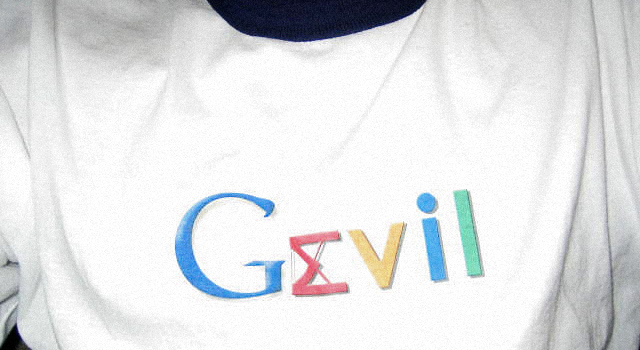 Google has been variously praised and derided for its corporate manta, “Don’t Be Evil”. For those who like to believe that Google has good intentions recent events strain these assumptions. The company was found to have been snooping on and collecting data from personal Wi-Fi routers. Is this the case of a lone-wolf or a corporate strategy?
Google has been variously praised and derided for its corporate manta, “Don’t Be Evil”. For those who like to believe that Google has good intentions recent events strain these assumptions. The company was found to have been snooping on and collecting data from personal Wi-Fi routers. Is this the case of a lone-wolf or a corporate strategy?
[div class=attrib]From Slate:[end-div]
Was Google’s snooping on home Wi-Fi users the work of a rogue software engineer? Was it a deliberate corporate strategy? Was it simply an honest-to-goodness mistake? And which of these scenarios should we wish for—which would assuage your fears about the company that manages so much of our personal data?
These are the central questions raised by a damning FCC report on Google’s Street View program that was released last weekend. The Street View scandal began with a revolutionary idea—Larry Page wanted to snap photos of every public building in the world. Beginning in 2007, the search company’s vehicles began driving on streets in the United States (and later Europe, Canada, Mexico, and everywhere else), collecting a stream of images to feed into Google Maps.
While developing its Street View cars, Google’s engineers realized that the vehicles could also be used for “wardriving.” That’s a sinister-sounding name for the mainly noble effort to map the physical location of the world’s Wi-Fi routers. Creating a location database of Wi-Fi hotspots would make Google Maps more useful on mobile devices—phones without GPS chips could use the database to approximate their physical location, while GPS-enabled devices could use the system to speed up their location-monitoring systems. As a privacy matter, there was nothing unusual about wardriving. By the time Google began building its system, several startups had already created their own Wi-Fi mapping databases.
But Google, unlike other companies, wasn’t just recording the location of people’s Wi-Fi routers. When a Street View car encountered an open Wi-Fi network—that is, a router that was not protected by a password—it recorded all the digital traffic traveling across that router. As long as the car was within the vicinity, it sucked up a flood of personal data: login names, passwords, the full text of emails, Web histories, details of people’s medical conditions, online dating searches, and streaming music and movies.
Imagine a postal worker who opens and copies one letter from every mailbox along his route. Google’s sniffing was pretty much the same thing, except instead of one guy on one route it was a whole company operating around the world. The FCC report says that when French investigators looked at the data Google collected, they found “an exchange of emails between a married woman and man, both seeking an extra-marital relationship” and “Web addresses that revealed the sexual preferences of consumers at specific residences.” In the United States, Google’s cars collected 200 gigabytes of such data between 2008 and 2010, and they stopped only when regulators discovered the practice.
Why did Google collect all this data? What did it want to do with people’s private information? Was collecting it a mistake? Was it the inevitable result of Google’s maximalist philosophy about public data—its aim to collect and organize all of the world’s information?
Google says the answer to that final question is no. In its response to the FCC and its public blog posts, the company says it is sorry for what happened, and insists that it has established a much stricter set of internal policies to prevent something like this from happening again. The company characterizes the collection of Wi-Fi payload data as the idea of one guy, an engineer who contributed code to the Street View program. In the FCC report, he’s called Engineer Doe. On Monday, the New York Times identified him as Marius Milner, a network programmer who created Network Stumbler, a popular Wi-Fi network detection tool. The company argues that Milner—for reasons that aren’t really clear—slipped the snooping code into the Street View program without anyone else figuring out what he was up to. Nobody else on the Street View team wanted to collect Wi-Fi data, Google says—they didn’t think it would be useful in any way, and, in fact, the data was never used for any Google product.
Should we believe Google’s lone-coder theory? I have a hard time doing so. The FCC report points out that Milner’s “design document” mentions his intention to collect and analyze payload data, and it also highlights privacy as a potential concern. Though Google’s privacy team never reviewed the program, many of Milner’s colleagues closely reviewed his source code. In 2008, Milner told one colleague in an email that analyzing the Wi-Fi payload data was “one of my to-do items.” Later, he ran a script to count the Web addresses contained in the collected data and sent his results to an unnamed “senior manager.” The manager responded as if he knew what was going on: “Are you saying that these are URLs that you sniffed out of Wi-Fi packets that we recorded while driving?” Milner responded by explaining exactly where the data came from. “The data was collected during the daytime when most traffic is at work,” he said.
[div class=attrib]Read the entire article after the jump.[end-div]
[div class=attrib]Image courtesy of Fastcompany.[end-div]
